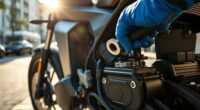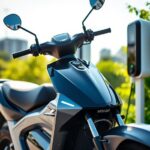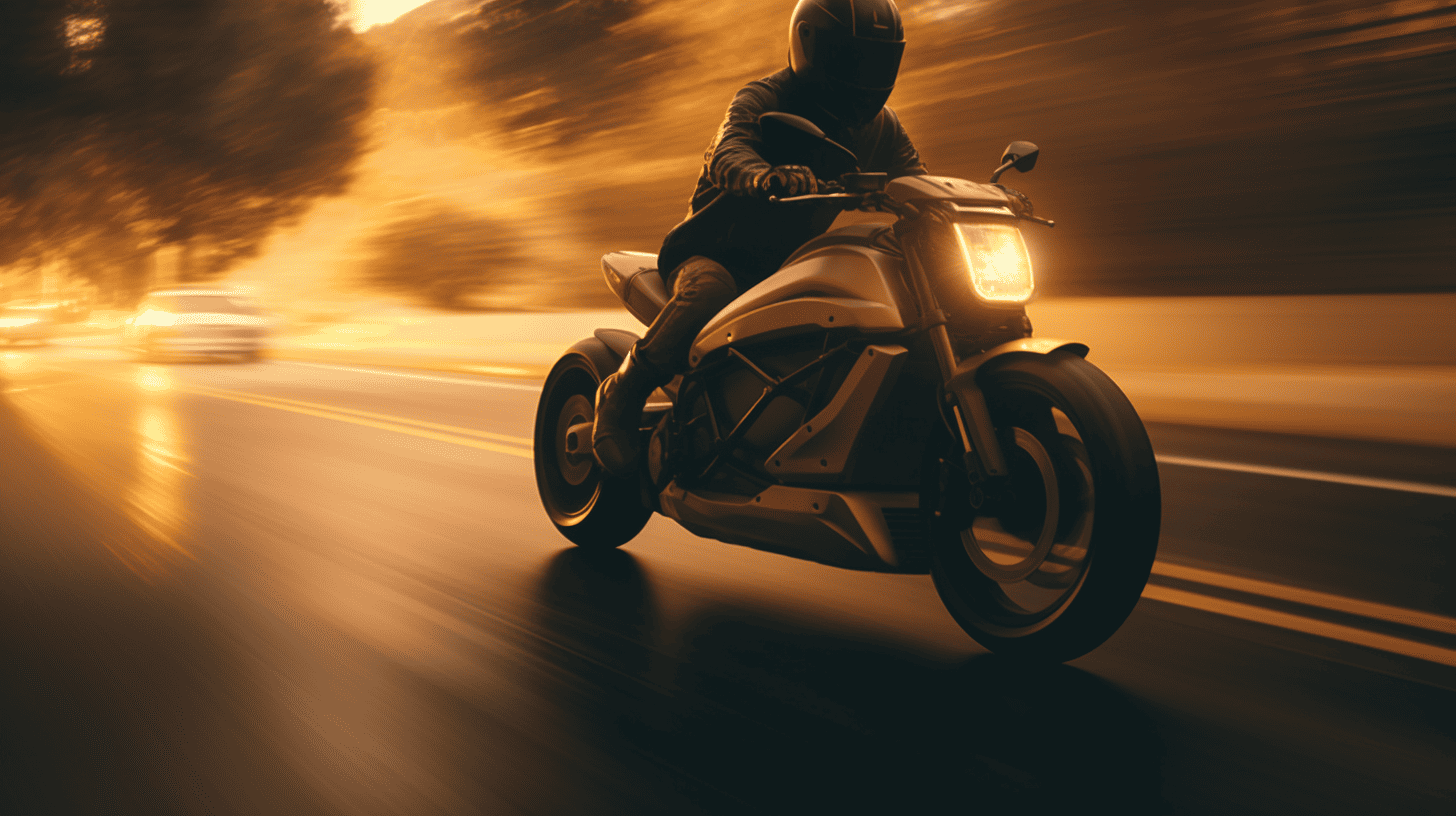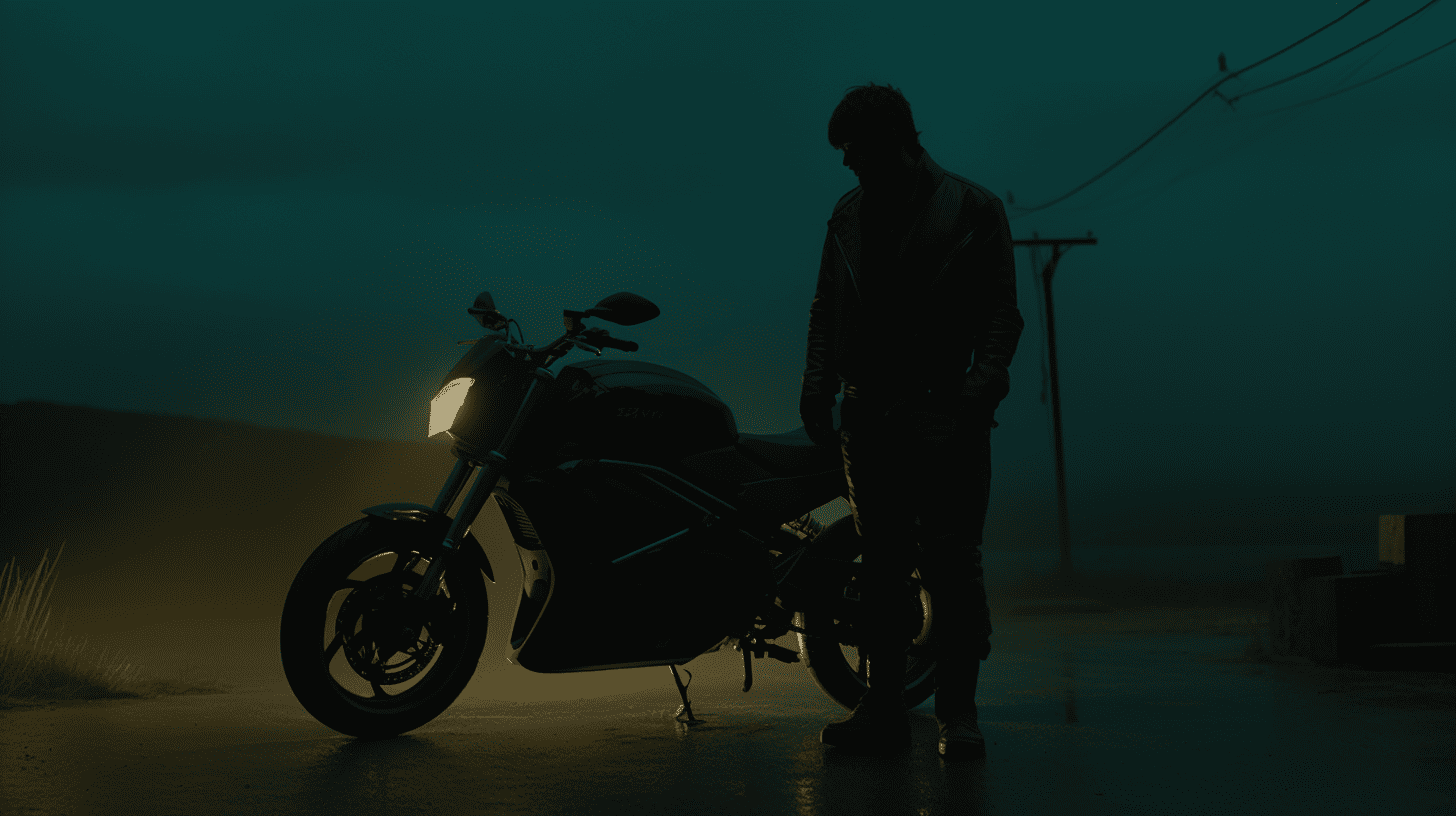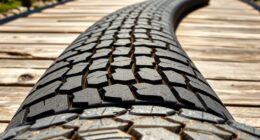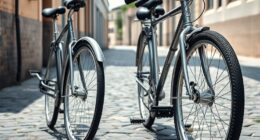To charge your electric motorbike, you’ll find various stations mainly in urban centers and along highways, using Level 2 and DC fast chargers for quick top-ups. Make sure to check connector compatibility and use proper cables for safe charging. Fast chargers are handy but can stress your battery if used excessively. Planning your routes with charging stops and following best practices for maintenance and storage will help your bike last longer. Keep exploring for detailed tips and tricks.
Key Takeaways
- Public charging stations, including Level 2 and DC fast chargers, are mainly available in urban areas and along highways.
- Compatibility of connectors like Type 2, CCS, or CHAdeMO is essential to ensure safe and efficient charging.
- Fast chargers provide quick top-ups but may accelerate battery aging if used excessively; balancing with slower charging prolongs battery life.
- Apps like PlugShare and ABRP help locate stations, verify availability, and plan routes effectively for electric motorbikes.
- Proper route planning, connector verification, and maintenance practices optimize charging efficiency and extend battery lifespan.
Types of Charging Stations and Their Locations
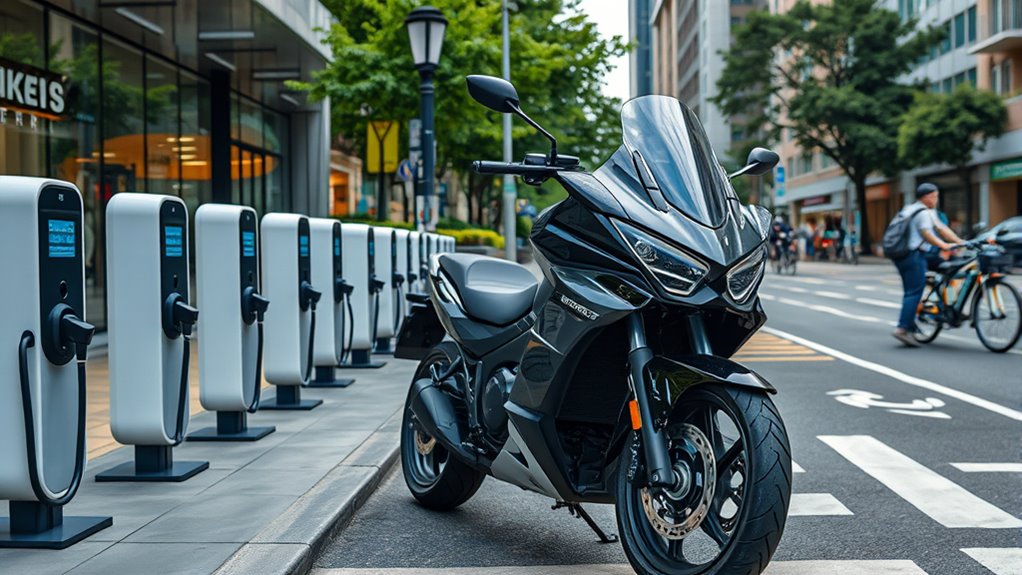
Where are you most likely to find charging stations for electric motorbikes? Public charging stations are mainly located in large cities and along highway corridors, making long-distance travel more feasible. Level 2 charging stations are common at these locations, offering faster charging compared to standard outlets. European Type 2 connectors support up to 43kW, fitting most motorcycle needs, but compatibility varies. DC fast charging stations, which deliver rapid power, are less widespread but typically found along major travel routes, providing 60-100 miles of range in 20-30 minutes. To locate charging station locations, apps like PlugShare and ChargePoint are invaluable. They help you verify availability and operational status, ensuring you can plan your trips efficiently and avoid range anxiety. Understanding the different charging station types and their capabilities can further enhance your charging strategy. Additionally, the availability of specialized motorcycle charging stations is increasing, making it easier for motorbike riders to find suitable power sources. It is also helpful to stay informed about upcoming developments in charging infrastructure, which is essential for keeping pace with industry transformations and ensuring seamless travel. Keeping track of advancements in charging technology can help you make more informed decisions about your electric motorbike journeys.
Understanding Different Charging Levels and Speeds

Understanding different charging speeds helps you choose the right station for your needs. Compatibility between your motorbike and chargers, as well as connector types, affects how quickly you can recharge. Knowing these factors guarantees you get the most efficient and convenient charging experience. Additionally, understanding whether your charging station is frost-free or not can influence how well it maintains performance over time. Being aware of charger types and standards can also help you select stations that suit your vehicle’s specifications and ensure safe, reliable charging. Regular maintenance and choosing high-quality filters can help prolong the lifespan of your equipment and optimize performance. Recognizing relationship dynamics can also aid in addressing any emotional or technical issues that might arise during the charging process. Moreover, selecting organic and natural juices for post-charge recovery can support overall health and wellness.
Charging Speed Variations
Charging speeds for electric motorbikes vary considerably depending on the type of charging level and equipment used. The charging rate and charge time differ between Level 1, Level 2, and DC Fast Charging. With Level 1, you get about 3 miles of range per hour, taking roughly 8 hours for a full charge. Level 2 charging boosts your charging speed, adding around 30 miles per hour and reducing charge time to 1–4 hours. DC Fast Charging delivers high power, enabling about 80% charge in just 20–30 minutes. Keep in mind, the onboard charger capacity and connector type influence the overall charging rate. Factors like station power output and battery size also impact how quickly you can recharge your motorbike. Understanding charging infrastructure can help you plan more effectively for long trips. Additionally, charging speed variations are influenced by advancements in AI-driven technologies that optimize charging algorithms for efficiency. A good understanding of charging levels can help you select the appropriate stations for your needs. For instance, newer chargers incorporate smart charging features that adapt to your bike’s battery condition, further enhancing charging speed and safety. Moreover, manufacturers are increasingly integrating advanced battery management systems that improve charging efficiency and longevity, making faster charging safer and more reliable. Faster charging depends on both station power and your bike’s capabilities.
Compatibility and Connectors
Choosing the right connectors is key to ensuring your electric motorbike charges efficiently and safely. Different bikes require specific connectors, like Type 2 for Level 2 charging or standard household plugs for Level 1, which affects compatibility with charging stations. Level 3 DC fast chargers often use CCS, CHAdeMO, or NACS connectors, but these aren’t always compatible with motorcycle charging ports. The charging capacity depends more on the charger’s power output, measured in kW, than just the connector type, influencing how fast you can charge. Not all connectors support every charging level; for example, Type 2 connectors handle up to 43kW, suitable for most motorcycle needs. Ensuring the connector matches your motorcycle’s inlet socket is essential for safe, efficient, and compatible charging.
Compatibility of Connectors and Charging Cables

Since electric motorcycles rely on specific connectors like Type 2 or J-1772, guaranteeing compatibility between your bike and charging station is essential. Using the right connectors and charging cables guarantees safe, efficient charging and protects your battery. Keep in mind:
Ensuring connector compatibility is key for safe, efficient electric motorcycle charging.
- Not all charging cables are universal; always match your connector type.
- Compatibility prevents potential damage to your bike or charger.
- Some stations may need adapters for incompatible connectors.
- Proper matching supports faster charging speeds and prolongs battery life.
- The charging capacity varies with the connector, with Type 2 supporting up to 43kW.
- Ensuring connector compatibility in your charging setup can help monitor and optimize charging conditions.
- Verifying your connection standards ensures seamless integration with various charging stations.
- Understanding zodiac compatibility traits can also influence your choice of compatible accessories and setups for a harmonious charging experience.
- Checking the charging station specifications before use ensures compatibility with your electric motorbike.
Focusing on compatibility ensures you get the most out of your charging stations without issues. Always verify your connector type and use the correct cables to enjoy safe, reliable charging every time.
Benefits and Drawbacks of Fast Charging Options
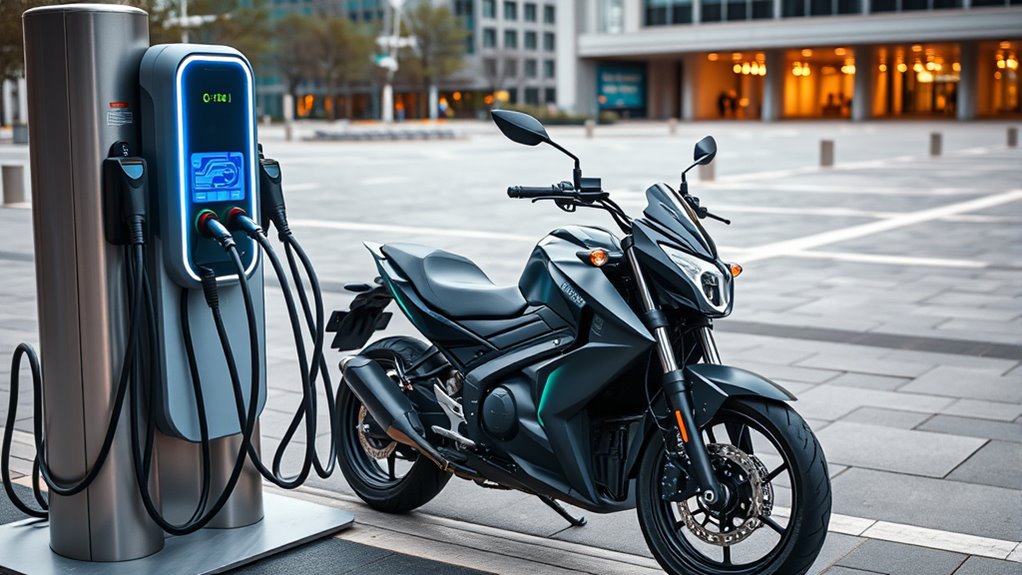
Fast charging gets you back on the road quickly, perfect for long trips or quick stops. However, it can strain your battery, leading to faster wear and reduced lifespan if used often. Plus, fast chargers are less common and more expensive, so you’ll need to weigh convenience against cost and long-term battery health.
Speed vs. Battery Health
Fast charging options offer a convenient way to quickly boost your electric motorbike’s range, allowing you to add up to 100 miles in about 20-30 minutes. However, frequent use of fast chargers can generate thermal stress, which may harm your battery’s health over time. While rapid chargers operate at high power levels between 50kW and 120kW, this speed can accelerate battery aging. Slower Level 1 and Level 2 charging methods help preserve battery longevity by reducing heat and stress on the cells. To maintain battery health, it’s best to reserve fast charging for long trips and stick to slower options for daily use. Balancing speed with battery care ensures your motorbike stays reliable and efficient. Sound healing science indicates that managing heat and stress on batteries is crucial for their longevity.
- Faster charging boosts range quickly, but risks thermal stress.
- Frequent fast charging may degrade battery health.
- Slower charging prolongs battery lifespan.
- High power levels accelerate battery aging.
- Use rapid chargers strategically for long trips.
Availability and Cost
Access to fast charging stations can considerably enhance your long-distance travel plans by providing quick top-ups, but these stations are less common and tend to be more expensive than regular Level 2 chargers. Fast charging options, such as DC quick chargers, deliver 50kW to 120kW power, allowing you to reach 80% charge in 20-30 minutes. However, these charge stations are mainly found near large cities or along highway corridors, so planning is essential for extended trips. The high costs of fast chargers, both for installation and per-use fees, make frequent use less economical compared to Level 2 charging at home. Plus, regularly relying on fast charging can generate excess heat and accelerate battery wear, impacting your motorcycle’s long-term battery health.
Planning Routes With Charging Stations in Mind
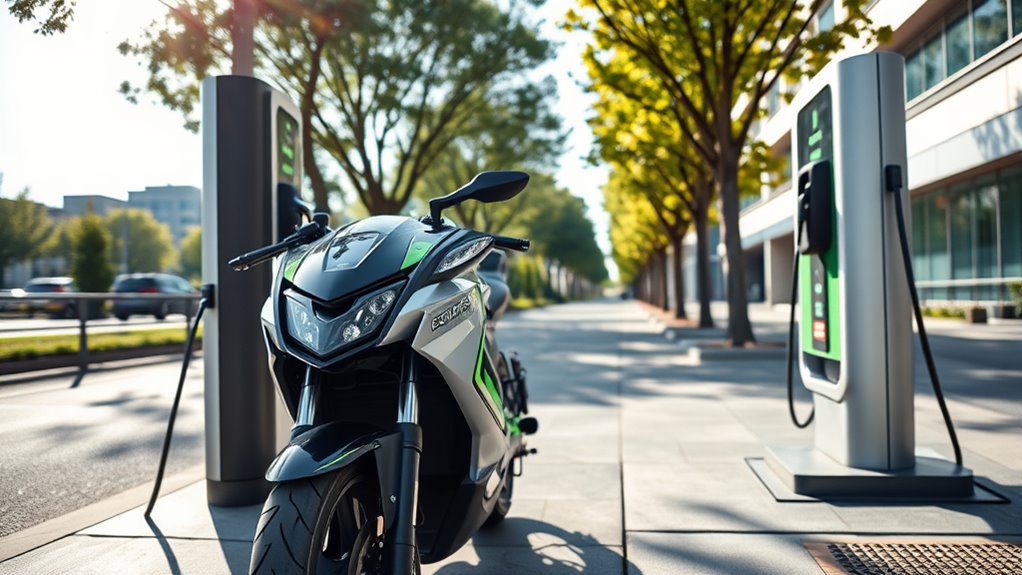
When planning a route for your electric motorbike, it’s essential to identify charging stations along your path to guarantee a smooth trip. Use route planning apps like PlugShare, EVgo, or ABRP to find charging options nearby. Prioritize stations with Level 2 charging or DC fast chargers to reduce downtime on long trips. Incorporate multiple charging stops at around 80% capacity to save time and extend your battery’s lifespan. Always check station compatibility with your motorcycle’s connectors, such as Type 2 or J-1772, before setting out. Keep in mind that busy fast-charging stations may have wait times during peak hours. Planning ahead ensures you won’t get stranded and makes your route more efficient.
Identify charging stations in advance with apps like PlugShare or ABRP to ensure a smooth, efficient electric motorbike trip.
- Find charging stations along your route with apps
- Focus on Level 2 and fast chargers for quick stops
- Schedule multiple stops at 80% charge
- Verify connector compatibility beforehand
- Anticipate wait times at busy stations
Tips for Safe and Efficient Charging Practices
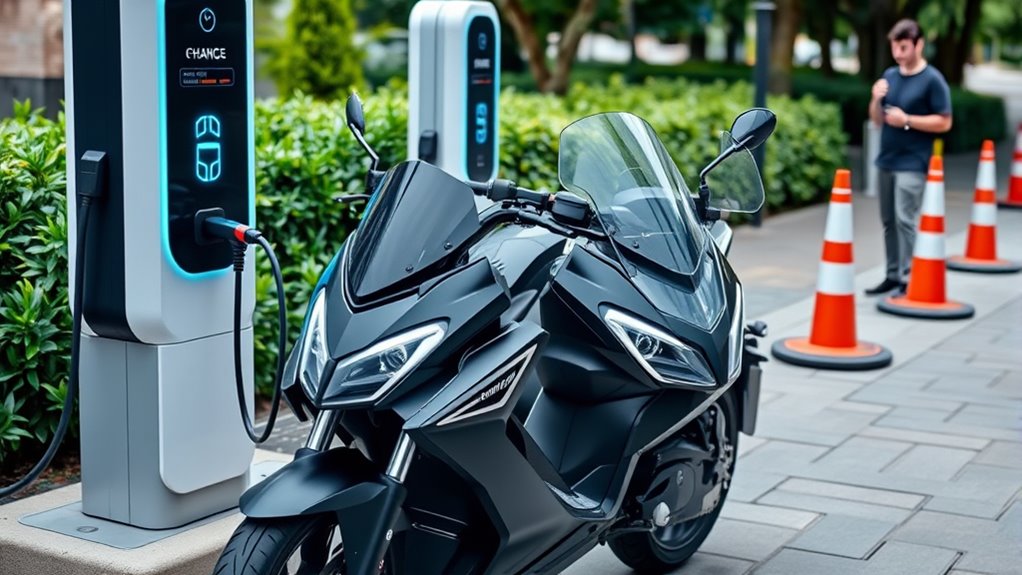
To guarantee safe and efficient charging of your electric motorbike, it’s essential to follow proper practices consistently. Always unplug the charger from your electric motorcycle before disconnecting it from the power source to prevent electrical hazards. Use chargers specifically designed for your electric motorcycle to protect the battery and ensure safety during the charging process. Charge in a dry, cool environment away from direct sunlight and moisture to lower the risk of electrical faults or fires. Regularly inspect charging cables and connectors for damage, replacing them if you notice wear or defects. Follow the manufacturer’s recommended charging times and procedures to avoid overcharging or undercharging, which can harm your battery’s health. These tips help ensure your electric motorcycle remains safe and ready for use.
Preparing Your Motorcycle for Winter Storage and Long-Term Maintenance
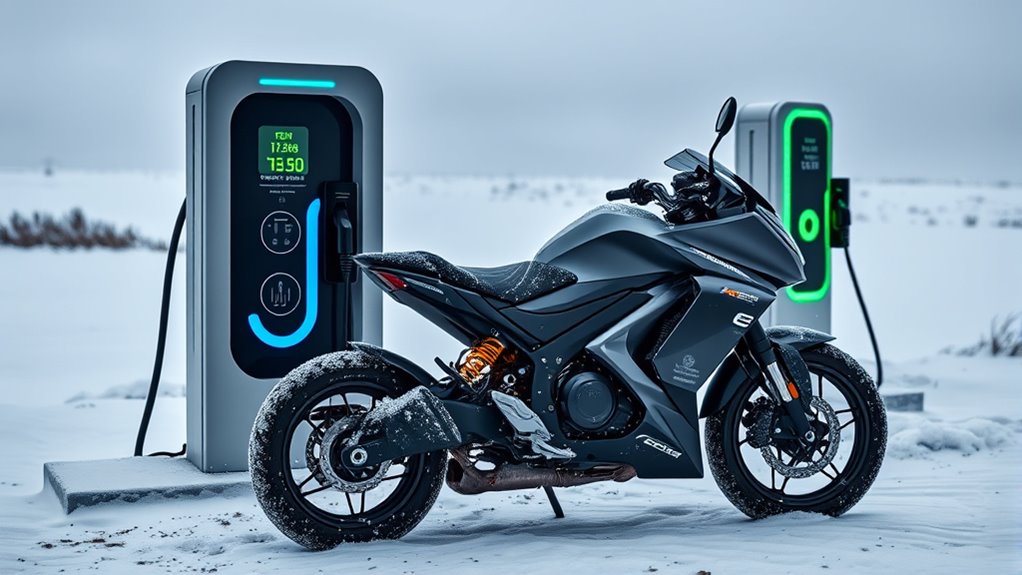
Preparing your electric motorcycle for winter storage requires careful attention to its battery and overall condition. To guarantee ideal long-term maintenance and prevent battery deterioration, fully charge the battery to around 60-80%. Store the motorcycle in a cool, dry place, away from direct sunlight and temperature fluctuations, which helps maintain battery health. Disconnect the charger and auxiliary power sources to avoid overcharging or electrical issues during winter storage. Regularly inspect the battery and wiring for signs of corrosion, damage, or moisture, and follow the manufacturer’s guidelines for winter storage. Remember to perform periodic gentle charging and battery conditioning as needed. This approach ensures your motorcycle stays in top shape, ready for the next ride when spring arrives.
Frequently Asked Questions
How Do You Charge Electric Motorcycles?
You charge your electric motorcycle by plugging it into a compatible outlet, like a Level 1 or Level 2 charger, depending on how quick you need it. Use the standard inlet socket and connect to public stations or your home charger. Apps like PlugShare help find nearby stations. Always follow the manufacturer’s guidelines to prevent battery damage and guarantee safe, efficient charging.
How Does the Charging System Work on a Motorcycle?
You might think charging your motorcycle is simple, but it actually involves a few key steps. When you plug in, the onboard charger converts AC power from the outlet into DC to fill the battery. The system also features safety measures like circuit breakers and temperature sensors to prevent damage. Depending on your charger’s capacity, it can charge slowly or rapidly, ensuring your bike is ready when you need it.
What Are the Rules for Electric Motorcycles?
When you ride an electric motorcycle, you need to follow local rules and regulations that guarantee safety and compliance. These include using approved charging stations that meet safety standards like UL or IEC, and ensuring the infrastructure matches your bike’s connector type and power requirements. You should also observe signage, accessibility, and safety measures at public charging spots. Staying informed about regional rules helps you ride legally and charge safely.
How Long Does It Take to Fully Charge an Electric Motorcycle?
Charging an electric motorcycle is like waiting for paint to dry – it varies. Typically, it takes 3 to 11 hours to fully charge, depending on your charger type. Using a standard outlet, it’s around 8-11 hours, but fast chargers can do it in about 20-30 minutes for 80%. Your bike’s battery size and charger capacity are key players in how long it takes to get back on the road.
Conclusion
Did you know that over 60% of electric motorbike owners plan to upgrade their charging setup in the next year? By understanding the different charging stations, levels, and safety tips, you can confidently navigate the expanding charging network. Proper planning guarantees you enjoy longer rides without range anxiety. Stay informed, keep your bike well-maintained, and embrace the eco-friendly future of motorbiking with smarter charging practices. Your journey to greener riding starts with one charge at a time.

